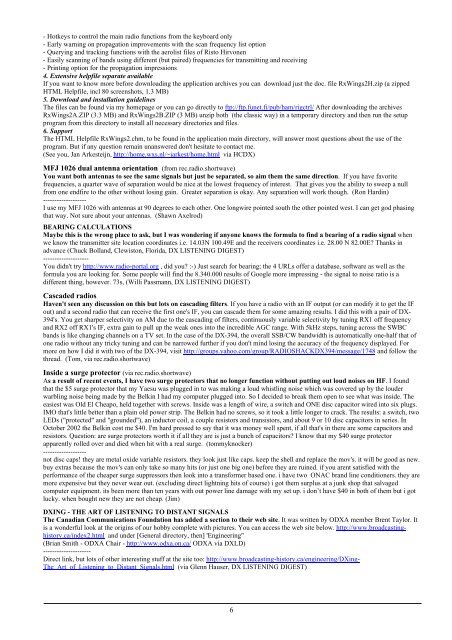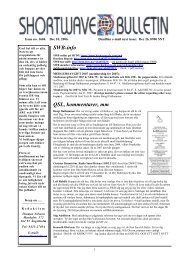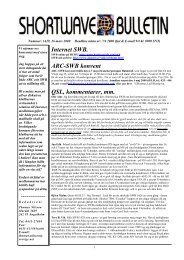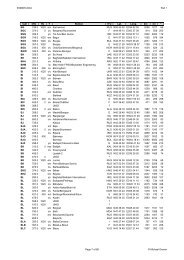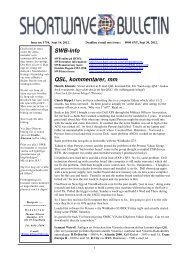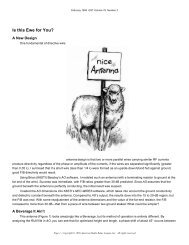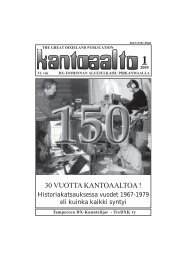SWB-info QSL, kommentarer, mm. - Hard-Core-DX.com
SWB-info QSL, kommentarer, mm. - Hard-Core-DX.com
SWB-info QSL, kommentarer, mm. - Hard-Core-DX.com
You also want an ePaper? Increase the reach of your titles
YUMPU automatically turns print PDFs into web optimized ePapers that Google loves.
- Hotkeys to control the main radio functions from the keyboard only<br />
- Early warning on propagation improvements with the scan frequency list option<br />
- Querying and tracking functions with the aerolist files of Risto Hirvonen<br />
- Easily scanning of bands using different (but paired) frequencies for transmitting and receiving<br />
- Printing option for the propagation impressions<br />
4. Extensive helpfile separate available<br />
If you want to know more before downloading the application archives you can download just the doc. file RxWings2H.zip (a zipped<br />
HTML Helpfile, incl 80 screenshots, 1.3 MB)<br />
5. Download and installation guidelines<br />
The files can be found via my homepage or you can go directly to ftp://ftp.funet.fi/pub/ham/rigctrl/ After downloading the archives<br />
RxWings2A.ZIP (3.3 MB) and RxWings2B.ZIP (3 MB) unzip both (the classic way) in a temporary directory and then run the setup<br />
program from this directory to install all necessary directories and files.<br />
6. Support<br />
The HTML Helpfile RxWings2.chm, to be found in the application main directory, will answer most questions about the use of the<br />
program. But if any question remain unanswered don't hesitate to contact me.<br />
(See you, Jan Arkesteijn, http://home.wxs.nl/~jarkest/home.html via HC<strong>DX</strong>)<br />
MFJ 1026 dual antenna orientation (from rec.radio.shortwave)<br />
You want both antennas to see the same signals but just be separated, so aim them the same direction. If you have favorite<br />
frequencies, a quarter wave of separation would be nice at the lowest frequency of interest. That gives you the ability to sweep a null<br />
from one endfire to the other without losing gain. Greater separation is okay. Any separation will work though. (Ron <strong>Hard</strong>in)<br />
-------------------<br />
I use my MFJ 1026 with antennas at 90 degrees to each other. One longwire pointed south the other pointed west. I can get god phasing<br />
that way. Not sure about your antennas. (Shawn Axelrod)<br />
BEARING CALCULATIONS<br />
Maybe this is the wrong place to ask, but I was wondering if anyone knows the formula to find a bearing of a radio signal when<br />
we know the transmitter site location coordinates i.e. 14.03N 100.49E and the receivers coordinates i.e. 28.00 N 82.00E? Thanks in<br />
advance (Chuck Bolland, Clewiston, Florida, <strong>DX</strong> LISTENING DIGEST)<br />
--------------------<br />
You didn't try http://www.radio-portal.org , did you? :-) Just search for bearing; the 4 URLs offer a database, software as well as the<br />
formula you are looking for. Some people will find the 8.340.000 results of Google more impressing - the signal to noise ratio is a<br />
different thing, however. 73s, (Willi Passmann, <strong>DX</strong> LISTENING DIGEST)<br />
Cascaded radios<br />
Haven't seen any discussion on this but lots on cascading filters. If you have a radio with an IF output (or can modify it to get the IF<br />
out) and a second radio that can receive the first one's IF, you can cascade them for some amazing results. I did this with a pair of <strong>DX</strong>-<br />
394's. You get sharper selectivity on AM due to the cascading of filters, continuously variable selectivity by tuning RX1 off frequency<br />
and RX2 off RX1's IF, extra gain to pull up the weak ones into the incredible AGC range. With 5kHz steps, tuning across the <strong>SWB</strong>C<br />
bands is like changing channels on a TV set. In the case of the <strong>DX</strong>-394, the overall SSB/CW bandwidth is automatically one-half that of<br />
one radio without any tricky tuning and can be narrowed further if you don't mind losing the accuracy of the frequency displayed. For<br />
more on how I did it with two of the <strong>DX</strong>-394, visit http://groups.yahoo.<strong>com</strong>/group/RADIOSHACK<strong>DX</strong>394/message/1748 and follow the<br />
thread. (Tom, via rec.radio.shortwave)<br />
Inside a surge protector (via rec.radio.shortwave)<br />
As a result of recent events, I have two surge protectors that no longer function without putting out loud noises on HF. I found<br />
that the $5 surge protector that my Yaesu was plugged in to was making a loud whistling noise which was covered up by the louder<br />
warbling noise being made by the Belkin I had my <strong>com</strong>puter plugged into. So I decided to break them open to see what was inside. The<br />
easiest was Old El Cheapo, held together with screws. Inside was a length of wire, a switch and ONE disc capacitor wired into six plugs.<br />
IMO that's little better than a plain old power strip. The Belkin had no screws, so it took a little longer to crack. The results: a switch, two<br />
LEDs ("protected" and "grounded"), an inductor coil, a couple resistors and transistors, and about 9 or 10 disc capacitors in series. In<br />
October 2002 the Belkin cost me $40. I'm hard pressed to say that it was money well spent, if all that's in there are some capacitors and<br />
resistors. Question: are surge protectors worth it if all they are is just a bunch of capacitors? I know that my $40 surge protector<br />
apparently rolled over and died when hit with a real surge. (to<strong>mm</strong>yknocker)<br />
-------------------<br />
not disc caps! they are metal oxide variable resistors. they look just like caps. keep the shell and replace the mov's. it will be good as new.<br />
buy extras because the mov's can only take so many hits (or just one big one) before they are ruined. if you arent satisfied with the<br />
performance of the cheaper surge suppressors then look into a transformer based one. i have two ONAC brand line conditioners. they are<br />
more expensive but they never wear out. (excluding direct lightning hits of course) i got them surplus at a junk shop that salvaged<br />
<strong>com</strong>puter equipment. its been more than ten years with out power line damage with my set up. i don’t have $40 in both of them but i got<br />
lucky. when bought new they are not cheap. (Jim)<br />
<strong>DX</strong>ING - THE ART OF LISTENING TO DISTANT SIGNALS<br />
The Canadian Co<strong>mm</strong>unications Foundation has added a section to their web site. It was written by O<strong>DX</strong>A member Brent Taylor. It<br />
is a wonderful look at the origins of our hobby <strong>com</strong>plete with pictures. You can access the web site below. http://www.broadcastinghistory.ca/index2.html<br />
and under [General directory, then] 'Engineering"<br />
(Brian Smith - O<strong>DX</strong>A Chair - http://www.odxa.on.ca/ O<strong>DX</strong>A via <strong>DX</strong>LD)<br />
---------------------<br />
Direct link, but lots of other interesting stuff at the site too: http://www.broadcasting-history.ca/engineering/<strong>DX</strong>ing-<br />
The_Art_of_Listening_to_Distant_Signals.html (via Glenn Hauser, <strong>DX</strong> LISTENING DIGEST)<br />
6


